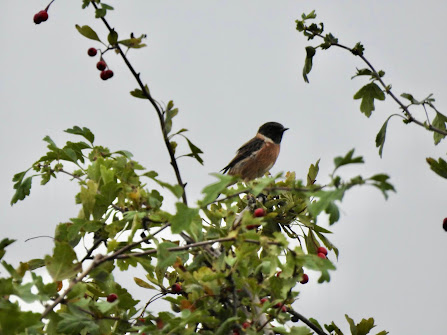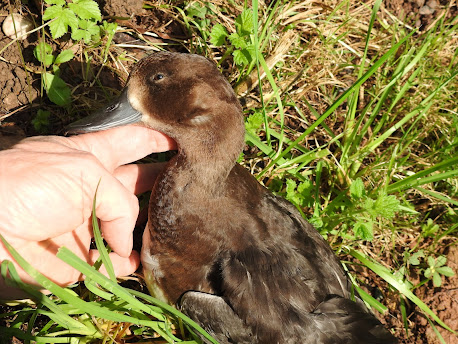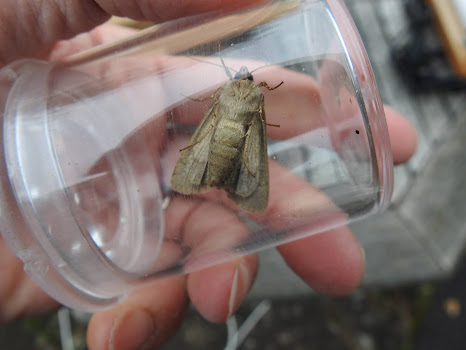This year I had arrived on the patch for the spring alldayer an hour before it got light, and although it paid off, I vowed I would not do so in September. So although I was pre-dawn again this morning, it was just on the cusp of getting light. At 5.35 I saw my first bird, a Barn Owl floating across the fields below Bannams Wood. Unlike in spring there was no bird song, just the constant ticking calls of Robins and the odd startled Blackbird.
For the first time in an autumn alldayer I had assembled a team, but in this pre-breakfast visit I was not expecting to see anyone. By 06.00 I was getting worried. Had I arrived too late to hear my other owl. Then at 06.05 a slightly croaky hoot of a Tawny Owl came from Bannams. Thank God I didn't have to come back tonight.
Down at the old pool I was rejoined by the Barn Owl. It landed on a post before five minutes of active hunting. Fantastic.
 |
| Barn Owl in the gloom |
My night's sleep had been disturbed when I had woken too early and had tried to imagine the day ahead. I had categorised the birds into "certainties" and "possibles". As I approached the flash field a hoard of Canada Geese which must have been roosting there, took off and headed out. The flash contained other certainties; Mallard, Teal, Snipe, Green Sandpipers. But there was no sign of the Marsh Harrier or Garganey. However, one "possible" did fly over. A party of seven Cormorants were the first here since the early spring. The furthest flash is very difficult to observe, but I found that by gaining height (and distance), I could see most of the water through the trees lining the Morton Brook. I added nothing certain, but a possible Shoveler was sufficient encouragement for me to try again later. By 07.30 I headed back for breakfast with the list on a rather disappointing 36 species.
At 08.50, thoroughly refreshed, I was back Netherstead. The team was on site and well spread. Mike Inskip was at the flashes, Martin Wheeler was in the same general area, and Sam McVie was making his way across Morton Common. I love the time between about 08.30 and 09.30, its a golden hour when the insects are taking to the wing, but are still too dozy to avoid capture. Birds know this, and I spent an age watching a dozen Chiffchaffs, a Lesser Whitethroat, and Blackcaps frantically catching them in the lee of the copse at Netherstead. Above me, a hundred hirundines dashed around with the same purpose. This could be their last chance to build up sufficient fat to start migrating south.
 |
| Chiffchaff |
The guys checked in. Martin had seen Grey Wagtail and Whinchat, and Sam had found a Yellowhammer at Morton Common, and later also added Linnet, Willow Warbler and Mistle Thrush, all birds we needed to see which could prove tricky. Actually the Yellowhammer was particularly impressive because they have been virtually absent all year though still occurring within a stone's throw of the patch.
The plan was to keep apart and try to cover as much ground as possible. Mike headed off on what was to prove a largely fruitless vigil down the south end, although he did find an extra Whinchat. Sam headed up the slope towards Bannams (I think), and Martin returned to the flash. I eventually joined him there, adding Long-tailed Tit and seeing a Holly Blue. Sorry, yes I know its supposed to be all birds.
 |
| Holly Blue |
After we gave up on the nearest flash we peeled back up the slope to view the furthest flash which did indeed contain Shoveler, in fact two of them.
The Whinchat count rose to five, all in the untouched centre strip of the now mown weedy field, and back at the Chat field I spotted the first Stonechat of the autumn, a nice male. The last three species before I headed home for lunch were Starling (a distant party heading towards Redditch), Reed Warbler, Treecreeper (Sam), and Skylark (Mike). We were on 60 species by midday.
The afternoon session is traditionally hard going. Its hot, you're tired, the birds are hiding. I started at Netherstead and found a Pied Wagtail there. This species disappears in early autumn, probably drawn away by nearby ploughed fields. Sam called in to report a Coal Tit at the edge of Bannams, and I headed to the south end.
 |
| Whitethroat feeding on blackberries |
 |
| Common Blue |
I relocated Mike's Whinchat and struggled through a field of thistles surrounded by flights of Goldfinches and distracted by a Common Blue. Several young Whitethroats were feeding on blackberries in a hedge. Mike called to say he was going home (Martin had left at lunchtime), and I saw Sam in the distance birding his way back to his car.
I was not expecting to find a candidate for bird of the day, but a flicker of orange in a row of dead elm saplings turned out to be a Redstart.
 |
| Redstart |
I snapped a record shot and rang Sam who returned to join me. Unfortunately the bird was lost down the hedge and we had to give up. Ironically, about two hours later I saw what was presumably the same bird from my car as I headed down the access road at Netherstead on my way home.
In the meantime I was resolved to give the flash field one last look. An immature Herring Gull flew over (species 64), and at the flash I heard a Kingfisher (species 65), before noticing that the Snipe and Teal were showing themselves. I counted 11 Snipe, and 48 Teal. The five Whinchats had relocated to the old pool field where photographic opportunities presented themselves.
 |
| Whinchat |
 |
| Migrant Hawker |
Noticing that a large party of Canada Geese was occupying the furthest flash, and being painfully aware that none of us had recorded a Greylag Goose today, I made my way back up the slope for one more scope view of the flash. I'm glad I did. No Greylag Goose, but sneaking its way along the back edge was a Common Sandpiper, the first here this year and the last species of the day.
The full list follows:
1. Canada Goose, 2. Teal, 3. Mallard, 4. Shoveler, 5. Red-legged Partridge, 6. Pheasant, 7. Cormorant, 8. Grey Heron, 9. Sparrowhawk, 10. Buzzard, 11. Kestrel, 12. Moorhen, 13. Lapwing, 14. Snipe, 15. Green Sandpiper, 16. Common Sandpiper, 17. Black-headed Gull, 18. Lesser Black-backed Gull, 19. Herring Gull, 20. Stock Dove, 21. Woodpigeon, 22. Collared Dove, 23. Barn Owl, 24. Tawny Owl, 25. Kingfisher, 26. Green Woodpecker, 27. Great Spotted Woodpecker, 28. Jay, 29. Magpie, 30. Jackdaw, 31. Rook, 32. Carrion Crow, 33. Raven, 34. Blue Tit, 35. Great Tit, 36. Coal Tit, 37. Skylark, 38. Swallow, 39. House Martin, 40. Long-tailed Tit, 41. Chiffchaff, 42. Willow Warbler, 43. Blackcap, 44. Lesser Whitethroat, 45. Whitethroat, 46. Reed Warbler, 47. Nuthatch, 48. Treecreeper, 49. Wren, 50. Starling, 51. Blackbird, 52. Mistle Thrush, 53. Robin, 54. Redstart, 55. Whinchat, 56. Stonechat, 57. Dunnock, 58. House Sparrow, 59. Grey Wagtail, 60. Pied Wagtail, 61. Chaffinch, 62. Goldfinch, 63. Linnet, 64. Bullfinch, 65. Yellowhammer, 66. Reed Bunting.
The value of having a team, and of having them well dispersed is clear. No one saw everything but the cumulative total was the best September day list total since I started. My personal total was 62, which compares unfavourably with 63 in 2020, and 64 in 2019.
We're all looking forward to the next one.










































